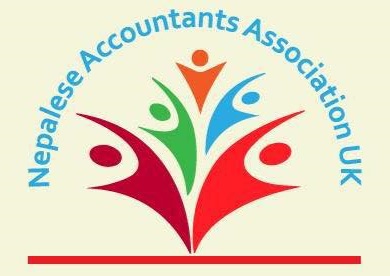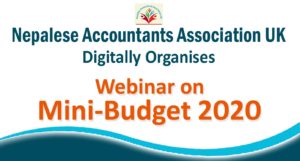The United Kingdom (UK) is widely considered as one of the most open economies in the world having a highly skilled human resources, better access to capital markets and world-class infrastructure.
The main aim of this article is to create awareness about some of the taxes which affect all of us in our day to day lives.
Few types of taxes:
- Income Tax
- National Insurance
- Capital Gains Tax
- Corporation Tax
- Value Added Tax
- Inheritance tax
- Income Tax
It is a tax which is paid on income. Income includes salary income, trading income, property income, interest on savings, dividend on shares etc. There are also exempt incomes on which there is no tax to pay. For example: Winnings from Lottery, Interest on ISA, Interest on National Saving Certificates etc.
There is a personal allowance of £12,500.00 for financial year 2020/21 (6th April 2020 to 5th April 2021). Hence, up to £12,500.00 of income, there is no tax to pay.
After personal allowance, up to £37,500.00, the tax rate will be 20%. The tax rate from £37, 501.00 to £150,000.00 will be 40% and from £150,000.00, the tax rate will be 45%.
The tax rate on dividend income will be 0% up to £2,000.00, 7.5% from £2,001.00 to £37,500.00, 32.50% from £37,501.00 to £150,000.00 and 38.10% from £150,000.00 onwards.
Income tax on salary is collected periodically by Pay As You Earn (PAYE) scheme. It is the employer’s prime responsibility to properly deduct income tax on salary and deposit it to H M Revenue and Customs (HMRC) within the deadline.
The self-employed person or person having property income has to register with HMRC by 5th October after the tax year end in which the source of income commenced. For example: If the self-employment begins on 14th April 2020, HMRC must be notified by 5th October 2021 in order to avoid penalty.
Unless, the salary exceeds £100,000.00, filing of tax return is not necessary. However, self-employed person has to file personal tax return for every financial year by 31st October, if done on paper, by 31st January, if done online. The tax liability must be paid by 31st January.
If you let a property, you need to calculate property income. Up until 2016/17, interest on mortgage was an allowable deduction. From 2017/18, this was taken off phase-wise by 25% in 2017/18, 50% in 2018/19, 75% in 2019/20 and 100% in 2020/21. Basic Rate Relief will be available though.
Up until, FY 2015/16, Wear and Tear Allowance of 10% on Gross Rental Income less expenses normally borne by tenant actually borne by Landlord. From FY 2016/17, this is no longer available. Instead, actual expenditure incurred to furnish the property will be allowable for deduction.
If you rent a room in your main residence, up to FY 2015/16, annual relief of £4,250.00 is available. This relief has been increased to £7,500.00 with effective from FY 2016/17.
There are various types of penalties and interest for not filing a tax return and late payment of tax. This is mostly dependent on potential loss of revenue, intentional and concealment.
- National Insurance (NI)
National Insurance is paid to qualify for certain benefits like State Pension. It is paid if one is:
- 16 years old or over
- an employee earning above £183 a week
- self-employed person making a taxable trading profit of £6,475.00 or more a year
In order to pay National Insurance, National Insurance Number is required which can be obtained from applying to Job Centre Plus.
Normally, once the person reaches pensionable age, National Insurance contribution is stopped.
There are 7 types of National Insurances.
- Class 1 National Insurance: It is further divided into two types. Class 1 Primary which is paid by employee earning above £183.00 weekly. The rate is 12% and after £962.00, the rate will be 2%.
Class 1 Secondary is paid by employer. Once the weekly earning exceeds £169.00, it is paid at 13.80%. The employer is responsible for proper deductions and payments of Class 1 National Insurance on behalf of the employee to HMRC within the payment dead line.
- Class 1A National Insurance: If the employer pays benefits in kind to employee i.e. car, fuel, accommodation, loan etc., this National Insurance is paid on the value of the benefits. This is fully borne by the employer and the rate is 13.80% on value of benefits. There is no tax free threshold for this National Insurance.
- Class 1B National Insurance: It is paid when employer wants to bear the tax on benefits extended to employee. This is also 13.80% on value of benefits.
- Class 2 National Insurance: Self-employed person has to pay Class 2 NI. It is £3.05 per week. If the earning is less than £6,475 a year, one can apply for exemption.
- Class 3 National Insurance: Class 3 NI is a voluntary contribution which is normally paid to cover the gap on National Insurance Record in order to qualify for certain benefits.
- Class 3 A National Insurance: This is also voluntary contribution. One can contribute in lump sum before you retire just to confirm your full entitlement to state pension post-retirement.
- Class 4 National Insurance: Self-employed person having taxable trading profit of more than £9,501.00 a year has to pay Class 4 NI. It is 9% after £9,501.00 and up to £50.000.00. Above £50,000.00, it is only 2%. This is paid along with personal tax return.
- Capital gains tax (CGT)
Capital gains tax is a tax on transfer of chargeable assets. Example of capital assets are business assets, property, shares. Car is not a chargeable assets. Hence, if you sell a car, the gain is exempt from CGT.
The gain arises on disposal, gift or giving away or swapping of chargeable assets. However, if you transfer a chargeable asset to your spouse or to a charity, there is no CGT.
The gain is calculated by taking away costs from proceeds of sale. In financial year 2016/17, the gain up to £12,300.00 is not taxable. This annual exemption is available to every individuals. This cannot be carried forward to next year.
From FY 2016/17, these rates changed to 10% for basic rate tax payer and 20% for higher and additional rate tax payer. These rates will not be applicable to gain on residential properties other than properties eligible for Private Residence Relief.
There are various CGT reliefs available to reduce or defer the gain. Some of them are Personal Private Residence Relief (PPR), Roll Over Relief etc.
If you sell you main residence, the likelihood is most of your capital gain will be reduced by PPR Relief. If you sell your buy-to-let, you need to pay CGT. The gain is split among owners of the property and subject to annual exemption.
CGT payable post 6th April 2020 transfer has to be reported and paid within 30 days of the date of sale.
- Corporation tax:
The corporation tax is normally paid by a company. The company has to pay corporation tax on its taxable profit. The taxable profit of the company comprises of trading profit, chargeable gain, non-trade loan relationship profit, property income. The corporation tax rate is currently 19% on taxable profits.
Normally, the corporation tax liability is paid after 9 months and 1 day after the company’s yearend. There will be late payment penalty and interest if it is not paid within aforesaid time.
The company has to file Corporation Tax Return to HMRC within one year from its yearend. There is a penalty if this return is not submitted by then.
- Value Added Tax (VAT):
VAT is a tax on consumer. The business has to compulsorily register for VAT if the taxable turnover exceeds £85,000.00. The business can be registered for VAT on voluntary basis. In this circumstance, the business has to prove why it wants to register for VAT voluntarily.
Vat register business has to collect VAT on its taxable supplies. If the supply is exempt or outside the scope of VAT, no VAT is collected from the consumer. The rates of VAT are Zero Rate (0%), Reduced Rate (5%) and Standard Rate (20%). Few examples of supplies which are out of scope, exempt, zero rated, reduced rated and standard rated:
Out of scope: Insurance, Bank charge, Salary etc.
Exempt: Education, NHS health services, Lottery tickets sales etc.
Zero: Passenger transport carrying more than ten passengers, books, children’s’ cloths and footwear.
Reduced: Electricity/Gas for domestic and residential use, Solar panels, renovating a dwelling that has been empty for at least 2 years.
Standard: If any supply is not out of scope, not exempt, not zero rated or not reduced rated, it is always standard rated.
Normally, the Vat registered business will collect VAT (Output VAT) on taxable sales or services and pay VAT (Input VAT) on purchases or expenses. The business can deduct Input VAT from output VAT and has to pay the difference to HMRC on periodic basis.
- Inheritance Tax (IHT):
Inheritance Tax is a tax on estate at the time of death of an individual. The estate may be possessions, property, savings etc. There is no Inheritance Tax if the estate is below £325,000.00 threshold. Above the threshold, tax rate is 40%. Following transactions do not attract Inheritance Tax:
- Gift to spouse
- Gift up to £3,000.00 per annum (Subject to 1 year carry forward)
- Gifts worth up to £250.00. Please bear in mind, this rule is all or nothing. If you gift £251.00, all is subject to tax. However, you have Nil Rate Band of £325,000.00 to take into consideration.
- £5,000 given to a child
- £2,500 given to a grandchild or great-grandchild
- £1,000 given to anyone else
There is a 7 year rule. It says that if you gift anything and survive 7 years, there is no Inheritance Tax implications as such. However, if you die within 7 years, the gift becomes chargeable and subject to Inheritance Tax. Then again, you can shelter Inheritance Tax up to £325,000.00.
On the death of a spouse, if the deceased spouse did not utilize Nil Rate Band (NRB) of £325,000.00, the unutilized Band can be transferred to surviving spouse. Hence, maximum NRB the surviving spouse could inherit, will be £650,000.00.
The valuation of assets transferred for Inheritance Tax purpose will be on Loss to Donor principle. Hence, it is not how much transferee gets rather it is how much loss the transferor suffers.
There are Inheritance Tax Reliefs like Business Property Relief and Agricultural Property Relief which may reduce the estate significantly thereby reducing IHT.
Usually the ‘executor’ of the will or the ‘administrator’ of the estate pays Inheritance Tax using funds from the estate.
An executor is a person named in the will to deal with the estate – there can be more than one. An administrator is the person who deals with the estate if there’s no will.
Finally….
Do you think there is some knowledge earned in between start to finish of above article? If the answer is yes, our aim is achieved. Furthermore, you also have to think about how to plan the taxes so that you can take good part of your income and gains to your pocket. Saving is as good as earning. A good tax planning looks at interaction of all the applicable taxes and minimizes overall tax and it is very practical on tax payer’s side.
Samir Nath Pyakuryal represents SNP Plus Ltd, Accountants and Tax Advisors. For further details or need to contact him, please visit www.snpplus.com.




